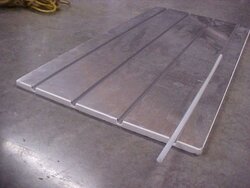in hot water said:
the extruded plates do move the energy better for two reasons. First they grip the tube tightly. As the most powerful means of heat transfer is conduction you want a tight tube fit.
Also the heavier gauge moves the energy to the edge of the fin better. Thin flashing gauge plates get cool before the heat gets to the outer edge. You really do get what you pay for with extruded plates. Plus lower operating temperatures.
Thin flashing plates are prone to making noise. It's called oil-canning and it sounds like those oil cans that you push the bottom. One manufacturer suggested you fasten only one side so the plate could expand without poping. But that defeats the purpose of a heat transfer plate if it is not touching. They finally pulled the thin flashing plates from their offering.
There are several versions and grades of extruded plates. I feel the "lite" version works fine, Radiant Engineering manufacturers the best they are sold under various radiant brands so shop for price.
With extruded plates you can insulate right against them, no need to leave an air space as the energy transfer is all conductive. Spray foam is a good way to seal the joist end spaces, around the rim joist. with fiberglass batts you want R-19 under radiant.
hr
A couple of questions... I've seen one suggestion (with a jig to make them) that one can make plates from the surplus ends of aluminum sheet generated by the seamless gutter folks (apparently they get 10-15' of waste every time they have to re-thread their machine for a different color, or change rolls) Seems like that would be better than the flashing weight plates, while still less money than the extruded plates - what do you think? The same site (I think it was "Builditsolar.com, but I'm not certain) also suggested using a thin layer of silicone caulk between the plate and tube - claimed better heat transfer and also reduced noise because the plate was glued to the tube.
The other question is what about insulation if one is going over a floor? In my house I am thinking that the first floor can be staple-up because it won't be a huge problem to pull down the sheetrock ceiling in the basement, and obviously insulation is not a problem there, but I can't pull down the ceiling in the living spaces to do staple up under the second floor, so I was thinking in terms of laying the tube above the subfloor - using Thermofin U or something along that line, but I don't see any good way to get insulation under it - since I'd be over a heated space, do I really need to worry about that? (If I do, how would you suggest handling it?)
Gooserider



